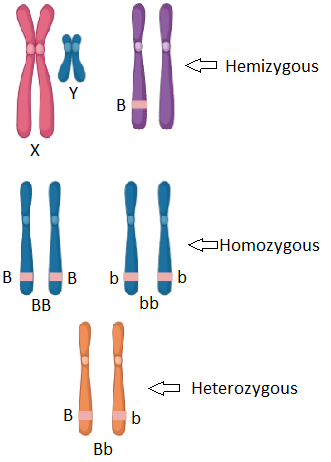
The condition in which only one allele of a pair is present in a diploid organism is known as
A. Homozygous
B. Heterozygous
C. Hemizygous
D. Incomplete dominance
Answer
556.5k+ views
Hint: Zygosity refers to the degree to which both copies of a gene have the same genetic sequence. This means the degree of similarity between the alleles in an organism. The condition given in the question is seen in heterogametic sex when a gene is present on the sex chromosome.
Complete answer: Zygosity tells about the degree of similarity between the two alleles in an organism that are present on the same locus of DNA. The terms homozygous, heterozygous, and hemizygous are used to refer the genotype of a diploid organism lying on a single locus of the DNA.

Hemizygous is a condition in which only one copy of allele is present for a particular trait. This condition is evident in heterogametic sex in which a gene is located on a sex chromosome. X chromosome in males has all of the hemizygous genes.
a) A homozygous cell is a cell in which identical alleles of a gene are present on both the homologous chromosomes. An individual can be homozygous-dominant and homozygous-recessive. The former refers to a condition in which two copies of an allele that code for a particular trait are dominant. This means that both of these alleles, when present individually, are capable of expressing themselves. The latter refers to the condition in which the alleles for a particular trait need to be present in pairs to express themselves.
b) Heterozygous is a condition in which the cell contains two different alleles of a gene at a particular gene locus. An uppercase letter and a lowercase letter are used to represent heterozygous alleles. For example, a heterozygous trait for tallness can be written as Tt.
c) Incomplete dominance is a condition where there are both recessive and dominant alleles but the dominant allele is not completely dominant over recessive. This results in the production of new phenotypes.
So, the correct answer is option C.
Note: Nullizygous is one of the very rare conditions in which an organism carries two mutant alleles for the same gene. Both the alleles are non-functional and cannot express themselves. Zygosity may also refer to the origin(s) of the alleles in a genotype.
Complete answer: Zygosity tells about the degree of similarity between the two alleles in an organism that are present on the same locus of DNA. The terms homozygous, heterozygous, and hemizygous are used to refer the genotype of a diploid organism lying on a single locus of the DNA.

Hemizygous is a condition in which only one copy of allele is present for a particular trait. This condition is evident in heterogametic sex in which a gene is located on a sex chromosome. X chromosome in males has all of the hemizygous genes.
a) A homozygous cell is a cell in which identical alleles of a gene are present on both the homologous chromosomes. An individual can be homozygous-dominant and homozygous-recessive. The former refers to a condition in which two copies of an allele that code for a particular trait are dominant. This means that both of these alleles, when present individually, are capable of expressing themselves. The latter refers to the condition in which the alleles for a particular trait need to be present in pairs to express themselves.
b) Heterozygous is a condition in which the cell contains two different alleles of a gene at a particular gene locus. An uppercase letter and a lowercase letter are used to represent heterozygous alleles. For example, a heterozygous trait for tallness can be written as Tt.
c) Incomplete dominance is a condition where there are both recessive and dominant alleles but the dominant allele is not completely dominant over recessive. This results in the production of new phenotypes.
So, the correct answer is option C.
Note: Nullizygous is one of the very rare conditions in which an organism carries two mutant alleles for the same gene. Both the alleles are non-functional and cannot express themselves. Zygosity may also refer to the origin(s) of the alleles in a genotype.
Recently Updated Pages
Master Class 12 Business Studies: Engaging Questions & Answers for Success

Master Class 12 Economics: Engaging Questions & Answers for Success

Master Class 12 English: Engaging Questions & Answers for Success

Master Class 12 Maths: Engaging Questions & Answers for Success

Master Class 12 Social Science: Engaging Questions & Answers for Success

Master Class 12 Chemistry: Engaging Questions & Answers for Success

Trending doubts
What are the major means of transport Explain each class 12 social science CBSE

Which are the Top 10 Largest Countries of the World?

Draw a labelled sketch of the human eye class 12 physics CBSE

Explain sex determination in humans with line diag class 12 biology CBSE

The pH of the pancreatic juice is A 64 B 86 C 120 D class 12 biology CBSE

Explain sex determination in humans with the help of class 12 biology CBSE




